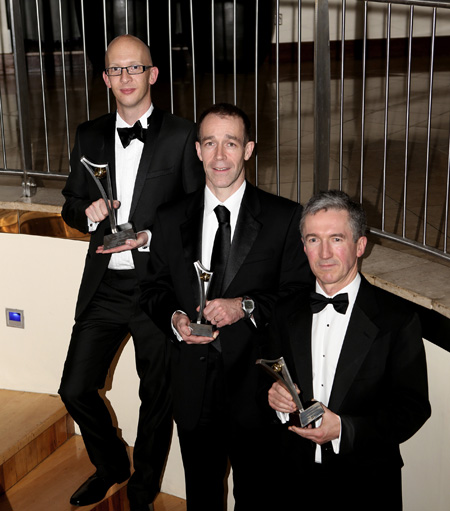Dr Peter Lee, a consultant anaesthetist with Cork University Hospital, who won the 2012 Clinical Innovation Award
Clinicians are often well placed to come up with ideas for new or improved medical technologies, but how do they go from concept to clinic? The Clinical Innovation Award, hosted by Cleveland Clinic and Enterprise Ireland, is one route for clinicians to move those ideas forward. Claire O’Connell caught up with the latest recipients, who are developing better ways to insert epidurals, heal wounds and predict who is at high risk of foot problems in diabetes.
“Clinicians have ideas all the time – but we don’t know how to take them to the next level,” says Dr Peter Lee, overall winner of the 2012 award.
A consultant anaesthetist at Cork University Hospital, Lee had an idea to improve the success rate of epidurals, which inserts a needle into a specific area of the spine in order to deliver nerve-blocking drugs.
“[Inserting an epidural needle] is a quite difficult technique to learn,” he explains. “It is done by feel and it can take awhile to learn it. And the problem is that when people are training, initially the failure rate can be high.”
If the needle isn’t properly in place, the epidural could fail, or it may cause severe headaches in the person who received it. “It’s not very common, but when you are a trainee it is more common,” says Lee.
A guiding sign
So what was his idea? He wanted to add a device to the epidural needle to indicate when the needle was correctly placed. The innovation could be useful not only for trainees, but also for more experienced clinicians who are facing a difficult case, he adds.
His idea might have gone nowhere unless Lee had become involved in a ‘BioDesign’ module being run at University College Cork, which invites clinicians, engineers and undergraduates to work together on projects.
Through that module, Lee and his collaborators developed the epidural indicator concept up to a point, but then they hit a barrier.
“We came to a serious problem,” he recalls. “We had the idea, we had it down on paper, but we were asking can we afford the time and money to take it to the next level or do we leave it fall?”
As good fortune would have it, the applications for the Clinical Innovation Award landed on Lee’s desk around that time, so he entered and eventually won the competition.
That means Enterprise Ireland is granting €15,000 to help develop the invention further, and Lee will also link in with Cleveland Clinic in Ohio.

Dr Peter Lee, winner of the 2012 Clinical Innovation Award; orthopaedic surgeon Seamus Morris, runner-up; and consultant endocrinologist Dr Sean Dinneen, also a runner-up
“Our plan now is to get a working prototype,” says Lee. “And we’ll be getting into the nitty-gritty of production costs and looking to start testing.”
He believes that clinicians often don’t see how important their insights from experience might be: “Clinicians maybe don’t realise maybe how valuable and valued their ideas can be – a lot of our ideas tend to be coffee room talk then it never happens, because we don’t have the time or the connections.”
A neater way to manage wounds
Orthopaedic surgeon Seamus Morris heard about the Clinical Innovation Award through his research connection with engineers at IT Tallaght, and that spurred the group to enter with an idea for more effective wound healing.
“It’s a device used in the management of complex wounds,” says Morris, who is a consultant at the Mater Misericordiae Hospital and UPMC Beacon Hospital in Sandyford.
Existing technologies for managing such wounds often mean the patient has to make repeated trips to the operating theatre, which places a burden on both the patient and the healthcare system, he notes.
“My innovation is a way of trying to get around that, to use one drain that can be left in for an extended period of time and so avoid the physiological hit to the patient through all those trips to the operating theatre and general anaesthetics,” says Morris. “Also for healthcare costs, if you can decrease the number of general anaesthetics, trips to the operating room and use of blood products, that would be a major saving for the healthcare system.”
The project will now receive support from Enterprise Ireland as a runner-up in the award, and the plan is now to complete feasibility studies and move towards patent application.
A step in the right direction
For Dr Sean Dinneen, being a runner-up in the award offers the chance to develop an innovation to assess the risk of a person with diabetes developing foot problems because of damage to nerves and blood vessels in the feet over time.
“Broadly speaking, people with diabetes are at risk of foot ulceration or developing foot problems,” explains Dinneen, who is a consultant endocrinologist with the Galway and Roscommon University Hospital Group and a senior lecturer in medicine at NUI Galway. “We want to assess risk in order to try and prevent those problems.”
With a team that includes Dr Martin Glavin and Dr Edward Jones at the university’s electronic engineering department, Dinneen is now looking to drive the assessment technology towards the marketplace. And he welcomes the encouragement that the recognition in the Clinical Innovation Award has brought.
“It does a lot for the team spirit,” he says. “There are good ideas out there and to be acknowledged in this way has been a huge lift.”
Siliconrepublic.com is hosting Med Tech Focus, an initiative which over coming months will cover news, reports, interviews and videos, documenting Ireland’s leading role in one of the hottest sectors in technology.